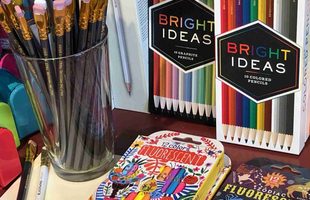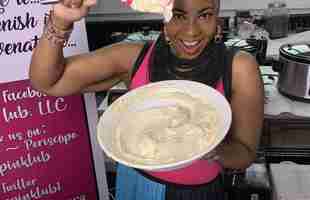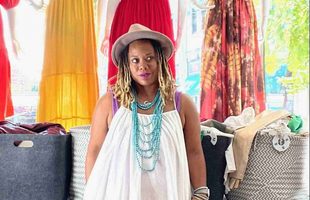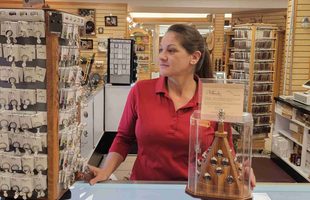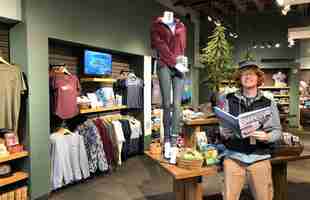In order to compete with the growing number of online retailers and all the bells and whistles they offer, Tiffany Kocurko, store director, Great Lakes Science Center, Cleveland, Ohio, said the first step is to create awareness for your museum’s online store. “People won’t shop it if they don’t know it’s there,” she said. The center’s website features images of the store and its products, and describes all of the fun things visitors can find at the store—which encourages them to shop when they visit.
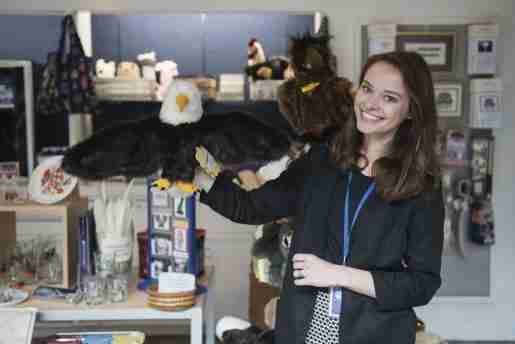 Bethany Fincher, visitor services associate, The Charleston Museum, photographed with puppets. The museum uses social media to promote new gift shop products or to pair items with holidays or special events
Bethany Fincher, visitor services associate, The Charleston Museum, photographed with puppets. The museum uses social media to promote new gift shop products or to pair items with holidays or special eventsIn addition, Kocurko said you need to have an assortment of unique items that support your mission and objectives. “We include messaging on the store’s home page that tells shoppers that their purchase supports the center,” she said.
Although it currently doesn’t sell merchandise online, Twinkle’s Toy Store at Lincoln Children’s Museum, Lincoln, Neb., makes sure its prices are competitive. “If there is a difference between a few cents to about $2, guests will pay the difference to have the product that day,” said Alisa Teevens, store manager. “However, if the difference is more than a dollar or two, guests will chose an online retailer with free shipping and wait the extra day or two to save money. When guests compare prices on their phones and see how close we are, it gives them a positive impression of the store, especially with museum stores having the stereotype of being more expensive, and they feel more inclined to purchase from us.”
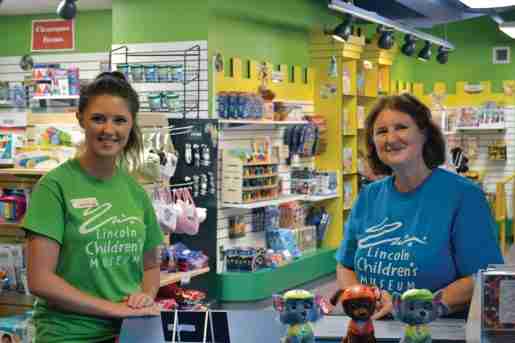 A mother and daughter team, Jean McBride and Heidi Wesely, work at Lincoln, Neb.’s Lincoln Children’s Museum and help out in the attraction’s Twinkle Toy Store. Travel games and activity books are great sellers for the store.
A mother and daughter team, Jean McBride and Heidi Wesely, work at Lincoln, Neb.’s Lincoln Children’s Museum and help out in the attraction’s Twinkle Toy Store. Travel games and activity books are great sellers for the store.The Cleveland Museum of Natural History, in Cleveland, Ohio, which is working toward having an online store soon, competes with online stores by developing and featuring iconic items that aren’t available elsewhere, such as merchandise that features Balto—the lead dog in the final leg of the serum run that saved Nome, Alaska, from a diphtheria epidemic in 1925. The mounted dog is displayed at the museum. “So much merchandise is available online, making it imperative to set yourself apart,” said Sue Divito, director of the museum store. “We take many phone orders for products featuring this iconic dog.”
Kimberly Zies, associate director of guest services, Children’s Museum of Denver at Marsico Campus, Denver, Colo., buys items that aren’t widely available at big box retailers to sell at her store. “We look for new, small vendors carrying funky, unique items that express our museum’s brand, look and feel,” she said. “We listen to customers and let them know that our prices are competitive with online retailers and that their purchase supports a local non-profit geared toward educating the community. We also point out that by purchasing at our store, they can walk away with a great new item in hand today—it’s not necessary to wait for an item to be mailed.”
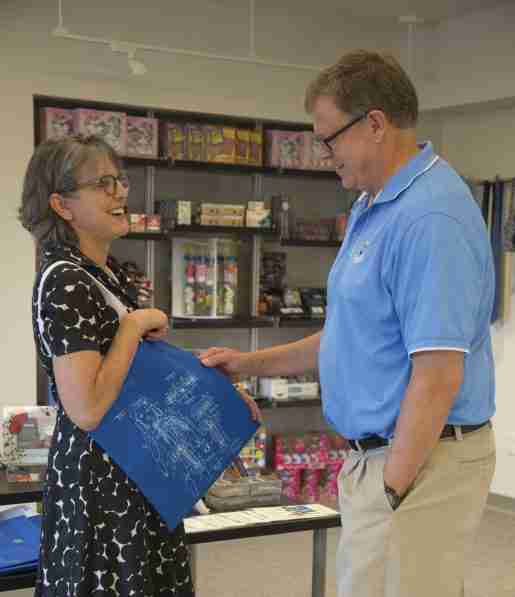 Patrons photographed with a tote bag at The National Museum of Toys and Miniatures in Kansas City, Mo. Discussions are underway within the organization about whether an online store presence would be profitable.
Patrons photographed with a tote bag at The National Museum of Toys and Miniatures in Kansas City, Mo. Discussions are underway within the organization about whether an online store presence would be profitable.Zies said the face-to-face guest experience in the shop is effective because customers still want to play, touch and feel products before buying them. “Customers want to ask questions and have the instant gratification of an answer on the spot,” she said.
Meg Hauser, visitor services manager, The National Museum of Toys and Miniatures, Kansas City, Mo., is a proponent of staying true to the institution’s mission and selling products that support it at the gift shop—which is around 300 square feet. “We tell customers that retail sale proceeds benefit the museum and its educational programming,” she said.
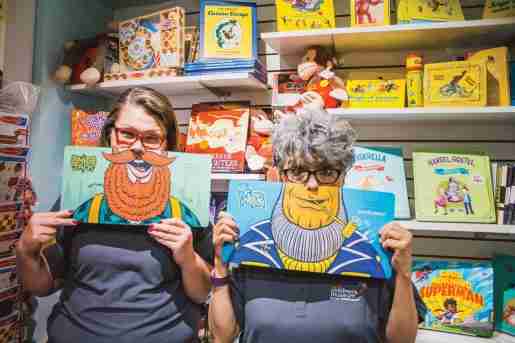 Kim Zies and Rachelle Rodriguez of the Children’s Museum of Denver at Marsico Campus. Customers still want to play with and touch and feel products before buying them, the associate director of guest services said.
Kim Zies and Rachelle Rodriguez of the Children’s Museum of Denver at Marsico Campus. Customers still want to play with and touch and feel products before buying them, the associate director of guest services said.Encouraging In-store Shopping
Twinkle’s Toy Store’s web page has a section that’s changed regularly called “featured products,” which has both pictures of products and fun descriptions. Sometimes it promotes special sales on its home page or events page. It uses social media and eblasts to alert guests to new products and upcoming sales at the store, which is under 500 square feet.
Offering real experiences is the key to getting people in your door, said Susan McKellar, chief of museum operations, The Charleston Museum, Charleston, S.C. The museum offers a variety of programming for both children and adults throughout the year (with an increase of children’s programming during the summer months). Furthermore, the museum’s permanent and temporary exhibits entice visitors to learn about Charleston and the Lowcountry throughout the year. “While you can look at magalodon teeth online, it’s much cooler to see one in real life,” she said.
 The immediate satisfaction of taking an item home, rather than waiting for a delivery, plus pricing that competes with online sellers, is a winning strategy for the Children’s Museum of Denver. Shown is Rachelle Rodriguez, retail associate.
The immediate satisfaction of taking an item home, rather than waiting for a delivery, plus pricing that competes with online sellers, is a winning strategy for the Children’s Museum of Denver. Shown is Rachelle Rodriguez, retail associate.The Charleston Museum uses social media to promote new gift shop products or pair items with holidays or special events. For example, it promoted George Washington’s double old-fashioned glasses and a book of his quotes for the Fourth of July, and encouraged guests to visit its Heyward-Washington House.
The web page for the Children’s Museum of Denver is simple and clean. “We advertise the brands we carry—which are unique,” Zies said. “We provide contact information so potential customers can reach out and ask questions or leave suggestions. We offer members a discount and encourage customers to follow us on social media for the most current information about sales and store events. We know customers won’t look at our store’s web page every day, but they do log into Facebook every day— where we can capture their attention and keep them updated on exciting offers.”
 A toy display at The Charleston Museum. Top sellers for children include arrowheads and shark’s teeth, gemstone collections and prehistoric animal kits.
A toy display at The Charleston Museum. Top sellers for children include arrowheads and shark’s teeth, gemstone collections and prehistoric animal kits.Best-sellers
Among its best-selling items online, Great Lakes Science Center’s space-themed merchandise does well because it’s home to the NASA Glen Visitor Center. At the 2,200 brick-and-mortar store, Himalayan salt lamps are the number one seller because they have a great promotional price. Staff are well trained in selling them and they’re a hot trend. Astronaut ice cream comes in second place, as it’s a novelty item when visiting the center. “It’s the perfect souvenir to take home,” Kocurko said.
Mini plasma balls are the third best-seller, which may be due in part to active demonstrations throughout the store. Two large plasma balls are on display in the exhibits; guests can bring part of the science center home with them, Kocurko said.
At Twinkle’s Toy Store, Melissa & Doug’s Spark Shark Fish Hunt pool toy is the top seller. It’s featured at the museum’s water exhibit, as well as on both the store’s web page and the staff recommendation tower in the museum’s lobby. Travel games and activity books, either by Imagine Ink or Melissa & Doug, are great sellers because parents want to keep their kids occupied while traveling.
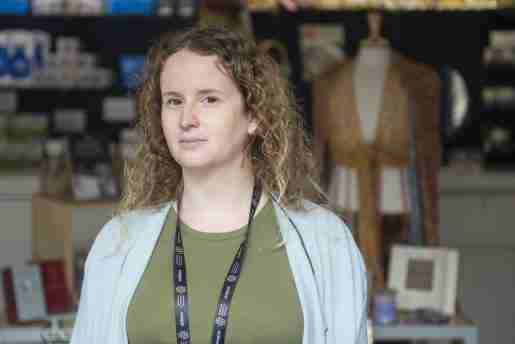 Susan J. McKellar, chief of museum operations, The Charleston Museum, Charleston, S.C. For the museum, offering real experiences is the key to getting people in the door. “While you can look at magalodon teeth online, it’s much cooler to see one in real life,” McKellar said.
Susan J. McKellar, chief of museum operations, The Charleston Museum, Charleston, S.C. For the museum, offering real experiences is the key to getting people in the door. “While you can look at magalodon teeth online, it’s much cooler to see one in real life,” McKellar said.Children’s books about Nebraska are also a hit. The book titles “Goodnight Nebraska” and “Little Nebraska” are popular with both local and out-of-town guests. “They are great reminders of the different places to see in Nebraska,” Teevens said. “They also help guests reminisce.”
At its 2,000-square-foot gift shop, Divito said the Balto plush dog is a top seller because the museum has the real dog in its exhibits and the plush looks just like him. Souvenir binoculars are another hit with the kids. “They are child sized with very good optics and have the museum’s logo on them,” she said. In addition, the natural tumbled stone bag is popular with youth. They get to fill a three-by-three inch bag with a selection of natural stones at a reasonable price.
At The Charleston Museum’s gift shop, top sellers for children include arrowheads and shark’s teeth, gemstone collections and prehistoric animals kits. “They do well because children just saw these items in the museum,” KcKeller said. “They have a low price point, so children can use their own money to buy them and parents don’t feel like it’s an extravagant purchase.”
Plush fly off the shelves at the 584-square-foot store at Children’s Museum of Denver. “A stuffed animal is like the comfort food of toys for kids,” Zies said. “Soft, fluffy fur and big, shiny eyes make them irresistible for girls and boys alike. Parents don’t seem to mind the purchase—even though we hear time and time again how many stuffed animals a child already has at home.”
Diecast cars, planes and trains are also a hit. These pullback, seemingly indestructible scale model toys appeal to both boys and girls, Zies says. Parents and grandparents love to reminisce about cars they once owned or play pretend with a school bus, fire truck or mini golf cart.
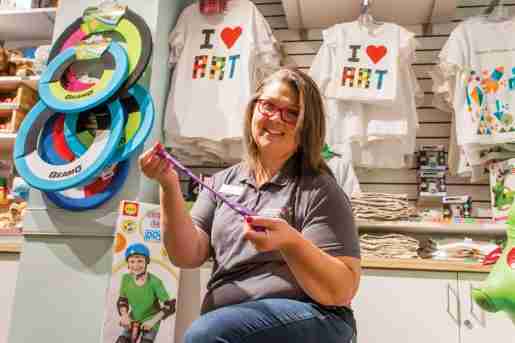 Kimberly Zies, associate director of guest services, Children’s Museum of Denver at Marsico Campus, Denver, Colo. The store looks for new, small vendors carrying unique items that express the museum’s brand, look and feel.
Kimberly Zies, associate director of guest services, Children’s Museum of Denver at Marsico Campus, Denver, Colo. The store looks for new, small vendors carrying unique items that express the museum’s brand, look and feel.Aero Motion’s Aero Props are a simple, brightly colored helicopter toy that is fully kid powered. “We brand ours with the museum’s logo, so the souvenir aspect makes it a great buy for under $2,” Zies said. “Our retail staff and volunteers love to demonstrate how easy little hands can make them fly high into our two-story lobby.” Annual gift shop sales are $240,000.
Online Versus In-Store
Kocurko said certain items sell better online than in-store and vice versa for a variety of reasons. “In-store sales are driven by products that complement or enhance what guests just experienced at the science center and are largely impulse driven,” she said. “They want to take home an item to remind them of their visit. Online sales are driven by a specific desire or need; perhaps it’s a gift for someone or they thought about purchasing something in the store but didn’t, and changed their mind after returning home.”
Zies said the Children’s Museum of Denver doesn’t have an online store because having one is like running a second store. “When I started an online store for another organization, we quickly realized that it would take much more staff, storage space and management if we offered all of the same products as the brick-and-mortar store,” she said.
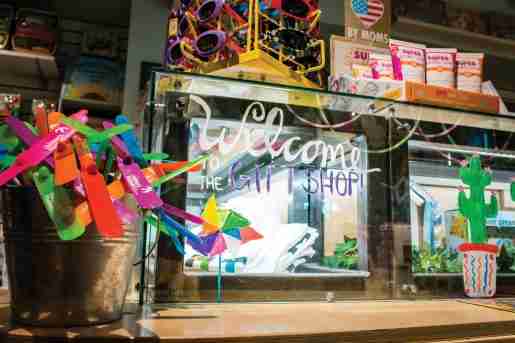 A Welcome to the Gift Shop sign at the Children’s Museum of Denver, Marsico Campus. “Customers want to ask questions and have the instant gratification of an answer on the spot,” the associate director of guest services said.
A Welcome to the Gift Shop sign at the Children’s Museum of Denver, Marsico Campus. “Customers want to ask questions and have the instant gratification of an answer on the spot,” the associate director of guest services said.Nonetheless, Zies would like to offer some merchandise online, but limit it to museum-branded items. “Several years ago, the turnkey fulfillment services offered weren’t quite as buttoned up as desired,” she said. “Now, it seems services have evolved and fulfillment through other companies is far more sophisticated and easier for smaller businesses. We would consider using a fulfillment service to have a web presence for merchandise in the near future.”
Hauser said the standard rates of return for non-profit retail online sales are not significant enough for the National Museum of Toys and Miniatures to prioritize the development of an online sales site. However, discussions are underway within the organization about researching whether an online store presence would be profitable. The store garners approximately $50,000 annually.
